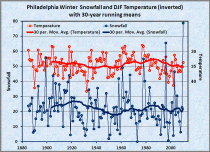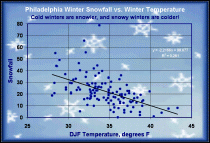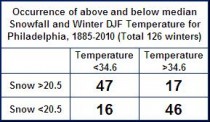By Dr. Richard Keen
The winter of 2009-2010 was a memorable one in the Northeast and Mid-Atlantic states, with locations like Philadelphia enjoying multiple massive snow storms that led to record totals for the winter. As with all exceptional weather events of late, the usual suspects blamed the occurrence on global warming. In a NOAA press release reported in USA Today, Jay Lawrimore stated that…
“Heavy snow, like the record snows that crippled Baltimore and Washington last winter, is likely to increase because storms are moving north.” To which I commented on “Watts Up With That” here on July 16, 2010 that Lawrimore’s remarks show a complete lack of understanding of weather (which makes up climate).
Anyone who spends a few winters on the East coast knows that snow there is generally caused by lows off the coast, and if the storms move north (as Lawrimore claimed), Baltimore, Philadelphia, NYC et al. find themselves in the warm sectors of the lows, and enjoy warm southerly winds and rain.
That’s the theory; how about some data to show that a warmer climate should lead to less snow, not more. The data are easy to find and interpret. More than a century of winter snow totals and average winter temperatures (December-January-February) are posted on the NWS Philadelphia web site.
Seasonal snow totals in Philadelphia are dominated by the occurrence (or non-occurrence) of large snow events (i.e., the snowiest winters have two or three major storms, and the least snowy winters had none). Here are some charts and correlations.

Chart 1 (enlarged here) compares yearly winter snow totals (in blue) with winter mean temperatures (in red). The small circles are for individual winters, and the heavy lines are 30-year running means (since climate is defined by some, such as the WMO, as a 30-year average). The winter temperatures are plotted upside-down to show the correlation better. And the correlation is that warm spells, like those in the 1930s, 1950s, and 1990s, have less snow overall than cold epochs like the 1900s, 1910s, 1960s, and 1970s.
Note that the 30-year running means are plotted and the end of each 30-year period, so while the 30-year means are shifted a bit from the highs and lows of the annual values, the 30-year curves for snow and temperature line up together. Also note that over 126 years, Philadelphia’s winters are not getting warmer or colder, and there’s not much change in snowfall.

Chart 2 (enlarged here) is a direct comparison of yearly snowfall with winter temperatures. The correlation coefficient (square root of R2) is greater than -0.5, which is not bad for anything in climate. It clearly shows a trend for more snow during colder winters, and less snow during mild winters. Philadelphia’s average annual snow fall is 20.5 inches, and the coldest winters produce about twice that amount, while the warmest winters are almost snowless.
The occurrence of snowy and less snowy winters during cold and mild winters is summarized in the table below. Although half of the winters are warmer than the median temperature (of course!) and half are colder, and half of the winters are snowier than median and half are less snowy, the co-occurrence of snow vs. temperature is not so even.

Enlarged here.
There are several ways to describe the relation between winter temperature and snowfall…
Colder winters are three times more likely to be snowier than the median.
Snowy winters are three times more likely to be cold.
Warm winters are three times more likely to have less snow than the median.
Less snowy winters are three times more likely to be mild.
One way the relation between snowfall and winter temperature CANNOT be described is that warmth leads to more big snowstorms and greater total winter snowfall.
By the way, I did this analysis for Philadelphia because it’s where I was raised and learned about weather before moving to Colorado. The warmers will no doubt raise their usual charge of “cherry-picking” when inconvenient data shows up. I challenge them to examine others locations in the northeast to find one they can “cherry pick” to support their claims. Until they do, the recent large snowstorms stand not as a symptom of global warming, but as yet another indication that global warming may not be happening at all. See PDF.
See also the New York Times story: ‘Bulge’ in Atmospheric Pressure Gives Us a Super-Cold Winter Amid Global Warming” here.





